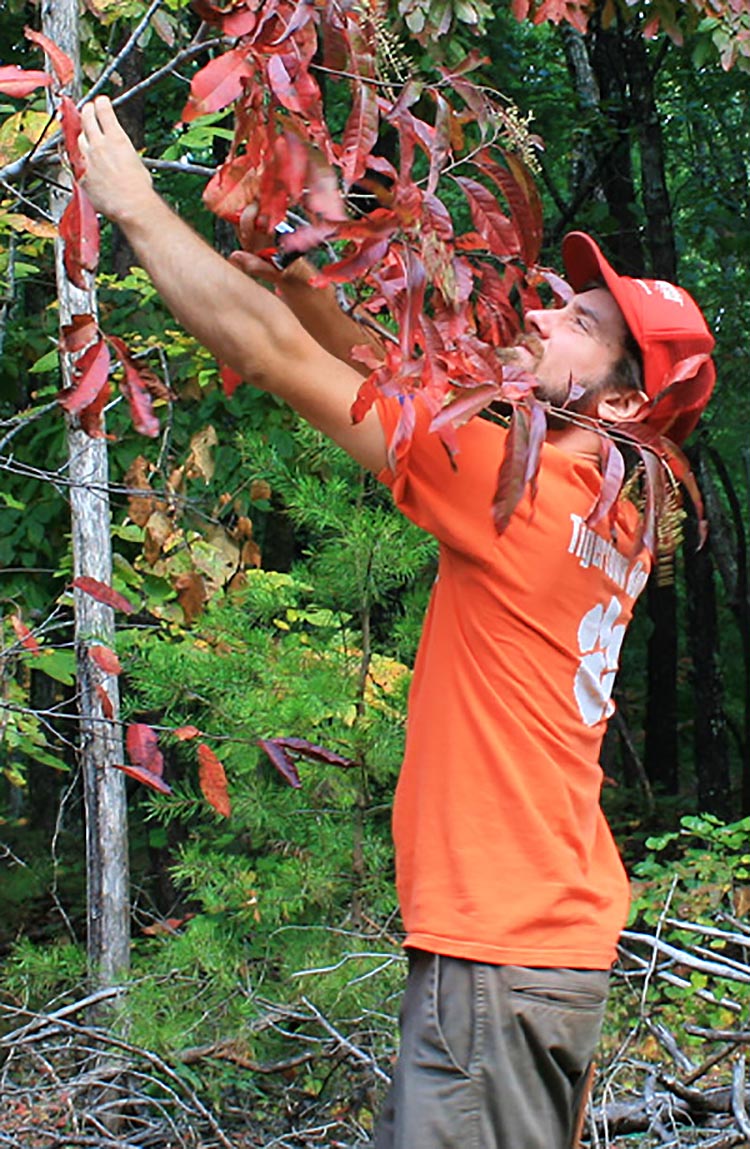Clemson Experimental Forest
The Clemson Herbarium is in the process of documenting the vascular plants of the Clemson Experimental Forest. Through projects, such as Creative Inquiry studies, the herbarium supervises the work of Clemson students who explore, document, collect and identify plants from throughout the natural divisions of the Clemson Experimental Forest. These plant collections are preserved and made into herbarium specimens — documented vouchers — evidence of the plants that grow within the forest. These projects help generate authenticated plant checklists which can be used by those who manage forest resources, those who use the forest as a teaching laboratory, and add to the enjoyment of those who visit the forest and delight in the beautiful and interesting plants that abound there.
An herbarium specimen is pressed, dried preserved plant material — identified, affixed to a mounting sheet and labeled with its scientific identification, collection location and the date. Each of the researchers here have produced herbarium specimens of their collected specimens — each specimen housed within the herbarium and with the potential of lasting hundreds of years.
All Clemson specimens — including those collected by student researchers — are available online at the SERNEC portal. For a spreadsheet copy of the Clemson Experimental Forest Master List, email the Clemson University Herbarium curator.
Example Creative Inquiry Projects
 ▧ “Fall Season Collection of Vascular Plants in the Clemson Experimental Forest, Keowee River Highlands, Natural Division 1” — Ben Case, Creative Inquiry student
▧ “Fall Season Collection of Vascular Plants in the Clemson Experimental Forest, Keowee River Highlands, Natural Division 1” — Ben Case, Creative Inquiry student
Case (shown in accompanying photo) documented Oxydendrum arboreum (sourwood) in his project. In his 100 collected plant specimens, 90% of the taxa had never been previously vouchered for this division. He also collected species that were first-time documentations in the Clemson Experimental Forest.
▧ “Spring Season Vouchering of Vascular Plants within the Clemson Experimental Forest: The South Peninsula Wildlife Division: 11” — Carl Max “Chase” Dixon III, Creative Inquiry student
Dixon documented 81 specimens (71 of them newly vouchered for Division 11), including one county record; one plant on the SCDNR rare, threatened and endangered list; and five species newly documented within the rest of the Clemson Experimental Forest.
▧ “Spring Season Survey of Vascular Plants in the Clemson Experimental Forest: East Dam Ravines Natural Division: 4” — Adam Forand, Creative Inquiry student
Forand documented slopes just south of Lake Issaqueena. He collected 90 plants; 87 of them newly documented to this division. Among these, two of them were first documented records for Pickens County. Two other plants had not been previously documented in the rest of the Clemson Experimental Forest prior to this time.
▧ “Spring Vascular Flora of Division 6 (Horsehead Point) of the Clemson Experimental Forest (2016)” — Lucy Rummler, Creative Inquiry student
Rummler assessed a collection area at a waterfall and amphibolite outcrop. Her study, which vouchered 65 specimens (from 34 families and 57 genera) added 47 new species to the previously-surveyed area. This project increased the documented diversity here by 25% and included several county records and newly added taxa in the overall Clemson Experimental Forest list.
▧ “Fall Season Collection of Vascular Plants in the Clemson Experimental Forest, Northeast Waterfalls Division 3 (2017)” — Christopher Williamson, Creative Inquiry student
Williamson’s project focused on plants in vicinities of two separate waterfalls (Todds Creek Falls and Waldrop Stone Falls). Of his 47 specimens, more than half had not been previously collected in Division 3, increasing the documentation of new taxa for that area by 13.4%.
▧ “Fall 2018 Survey of a High-Impact Vegetation Corridor Segment of Hunnicutt Creek: Clemson Campus” — Mekenna Rodgers, Creative Inquiry student
Forest remnants and vegetation buffers are important features of Clemson campus; Rogers surveyed plants in a vital segment of a natural buffer/high-impact vegetation corridor along Hunnicutt Creek, spanning from below Lightsey Bridge to Zeta Theta Street. Among her 82 vouchered taxa, 12 (14%) had never before been documented from either the campus region nor within the entire Clemson Experimental Forest.
